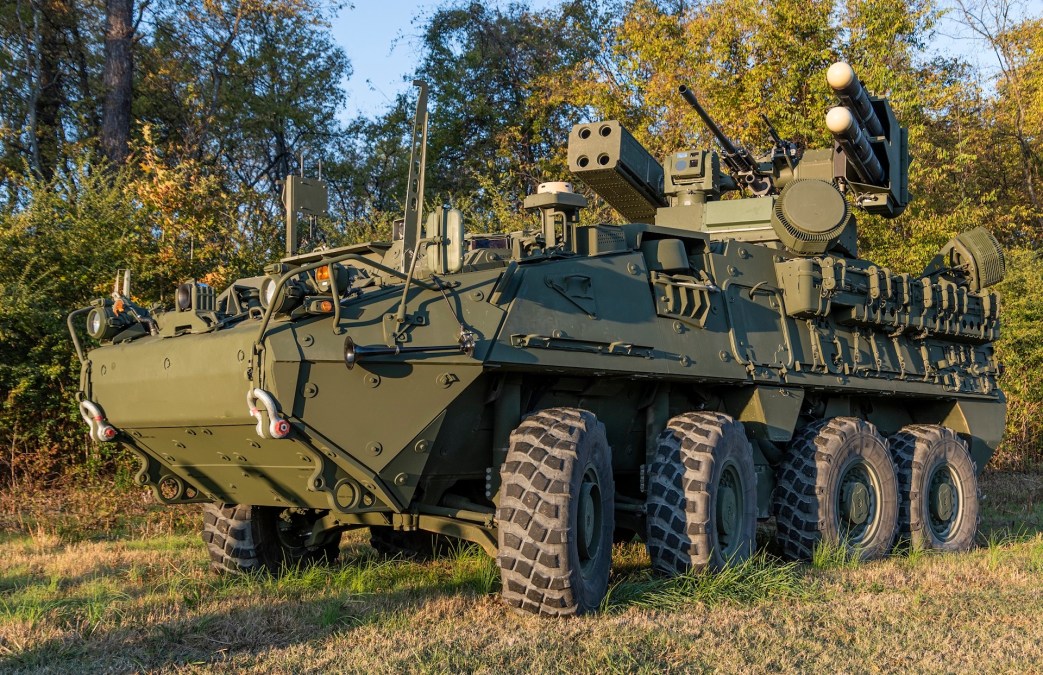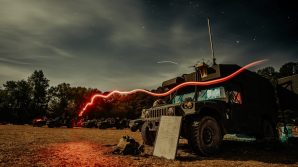Army rechristens drone-killing maneuver air defense system, eyes next increments

The Army unveiled a new name Saturday for its maneuver short-range air defense system as it plans for future increments designed to protect troops from drones and other overhead threats on the battlefield.
M-SHORAD increment one has been rechristened the SGT Stout in honor of Sgt. Mitchell Stout, an air defense artilleryman and Medal of Honor recipient who was killed in combat in Vietnam, the service announced Saturday during its 249th birthday festival near Fort Belvoir, Virginia.
The move comes as the force is rebuilding its capabilities to shield troops on the move from enemy unmanned aerial systems and other aircraft.
Increment one integrates Stinger missiles, a 30mm XM914 chain gun, a 7.62mm machine gun and multi-mission hemispheric radars onto a Stryker A1 armored vehicle.
Army officials describe it as a family of systems that can detect, track and engage UAS Groups 1-3, rotary-wing and fixed-wing aircraft, as well as rockets, artillery and mortars.
General Dynamics Land Systems, Leonardo DRS are Moog are key industry partners on the effort.
“The great thing about the SGT Stout system is that it combines multiple elements of capabilities that are critical on an ever-evolving battlefield. One is maneuver and mobility with the Stryker platform. Two, the inherent force protection that the Stryker platform and the turret provide. Three, the lethality aspects associated with the Stinger vehicle universal launch system … the associated built-in radar, and the FAADC2 command-and-control elements, along with the 30-millimeter chain gun, which provides not only air defense capabilities, but also self-protection capabilities, and then obviously inherent communications capabilities. So … it’s a mixture of many different vital capabilities that make it very effective on today and tomorrow’s battlefield,” Brig. Gen. Frank Lozano, program executive officer for missiles and space, told reporters during a roundtable ahead of the official announcement about the renaming.
The service used a rapid prototyping strategy for the program to speed things up. Three of the four initial battalions have already been fielded and the service is planning for more in the future.
“We now are actually fielding a short-range air defense system that among other things, provides counter-UAS capability to forward forces, which everyone can see are an increasing danger … So I think we really got this one right and we did it really fast,” Assistant Secretary of the Army for Acquisition, Logistics and Technology Doug Bush told reporters.
The service is planning to build 312 systems, although that could rise to 361, depending on future decisions, according to Lozano.
Meanwhile, officials are looking at what comes next.
Increment two and directed energy
Officials had previously envisioned increment two of M-SHORAD being equipped with a laser weapon, but the Army is still trying to flesh out its approach to putting directed energy systems on vehicles.
“We’re taking a very hard look at the full spectrum of directed energy capability. And the Army will likely be making decisions on that in the future, probably across the [2026 program objective memorandum] time frame. So we’re trying to determine right now what’s the best element of capability from a directed energy perspective [that] makes sense relative to the SGT Stout platform,” Lozano told reporters.
Bush suggested there are no concrete plans yet to add DE upgrades to that system.
“I think laser upgrades would be on a vehicle, [but] it might be a Stryker or it might be some other platform … To be to be determined,” he said.
“We’re still in prototyping phase for a lot of things. We’ve deployed a lot of things. I think the decision the Army’s working through now is just when to actually get to production on which of those is most promising, and in what form. But I believe I can say that directed energy will be part of the family of systems for UAS and air defense going forward. But the exact tech and mix is still being worked through by the air defense branch,” he told DefenseScoop at the roundtable, noting that prototyping activities will inform decisions tied to POM ’26, which covers 2026-2030.
“The critical decision is whether you put procurement dollars [into it] … To field at scale and to get industry, you know, actually ramped up for meaningful production, not smaller scale, you gotta lay in procurement dollars. That’s the hard choice in front of [the Army]. There are many priorities right for procurement dollars. But I think we’ve learned a ton from these prototypes, which is the idea and not a small investment. But I think at least now, our senior leaders have real data to go by,” he added.
A vehicle armed with a directed energy weapon won’t necessarily be referred to as an M-SHORAD increment, he suggested.
Meanwhile, the Army has deployed a 50-kilowatt laser system to the U.S. Central Command area of responsibility in the Middle East. Bush said the service is getting important feedback from the effort.
“We picked a Stryker to try to do the 50-kilowatt system. I think we’re learning a lot about the challenges of integration of that powerful laser system … on a vehicle versus doing it at a fixed site or versus doing a lower-power laser on a vehicle like a Stryker. So I think the learning that’s going on, though, is absolutely informing the POM decisions being made, budget decisions being made right now in terms of what is most likely to succeed first in the directed energy realm. You know, beyond that, the fact that it’s deployed and being used by real soldiers, again, that’s just the best test we can have. I can’t get into more detail on effectiveness right now because of just security concerns,” Bush told reporters.
Increment three and next-gen missiles
For what the Army is calling “increment three,” the service is looking to boost the capability of its missiles.
A development program is underway for the next-generation short-range interceptor that’s part of a future increment of the SGT Stout capability, Lozano noted.
“It’s really the replacement for the missile, right? So it’s the Stinger replacement, and obviously with that … we’re looking for something that has a shorter time of flight, that has greater range, and that has a seeker and a warhead tailored more towards those gen-five fixed-wing aircraft, the new variants of rotary-wing aircraft that we’re seeing, and especially against the UAS threat that we’re seeing continually evolve almost on a weekly and monthly basis. So that new interceptor in the future increment of the SGT Stout system is going to be key and critical to maintaining relevancy on a future battlefield,” he said.
Officials have a rapid prototyping effort underway using Middle Tier of Acquisition authority. Bush green-lit the program last year, according to Lozano.
“We’re coming to the end of the first year of that MTA effort,” Lozano told reporters. “The intent is to carry a couple of vendors forward for the next two years to get to a shoot off. And then, based on affordability aspects that have yet to be determined, we may continue to carry two vendors, or we may downselect to one and then go into a three-year very intense, aggressive developmental effort to try to get to a materiel solution that I can transition into potentially a major capability acquisition pathway. And we’re forecasting sometime within the FY ’28 timeframe is the current plan that I’m executing to.”
Bush said he anticipates a Milestone C decision in the second quarter of 2028.
Meanwhile, Army officials are open to incorporating vehicle-mounted Advanced Precision Kill Weapon Systems (APKWS) armed with proximity fuzes to defend against enemy drones.
“If that proves out, that is a very low-cost way compared to other systems that have a counter-UAS capability. I hope it works. The Army provides the rockets of course, it’s a Navy program — APKWS. But I can see the Army, if it works, procuring those proximity fuzes — also something we know how to do, something we have in the inventory — but buying more of those to give vehicles like SGT Stout. And even theoretically, if you carry that logic out, you know, something like a Bradley with the right kind of ammunition also would give you a counter-UAS capability. So you just have to have the right ammo,” Bush said.
Increment four
In May, the Army released a request for information for what it calls an increment four M-SHORAD capability.
“We’re really in the infancy of understanding what that program increment might look like. But the bottom line is, this platform is great for a lot of formations. But the current platform is not really optimized for light divisions like the 101st [Airborne], the 10th Mountain, the 82nd [Airborne]. And so the increment four RFI is really to try to start to understand what type of SHORAD capability, leveraging what we’ve already done with the SGT Stout, what kind of SHORAD capability do we need to evolve to for those lighter forces to make them effective, but also as agile as they need to be on tomorrow’s battlefield?” Lozano said.
According to the sources-sought notice, priority performance characteristics include Forward Area Air Defense Command and Control (FAADC2) and supporting equipment for vehicle commanders to manage engagements; reconfigurable mounted capability that’s tailorable to support various missions and effector load out; compliant with modular open systems architecture; and the capability to integrate onto platforms such as the Joint Light Tactical Vehicle and robotic vehicles.
Additional characteristics sought are the capability to support mounted and dismounted operations, with multiple effectors and sensors integrated on a single platform or “manned/unmanned pairs,” including kinetic effectors — such as the next-gen interceptor, Coyote, APKW and 30mm multi-mode proximity airburst — electronic warfare tools, and active and passive sensing combinations.
Other supporting capabilities that officials are eyeing include network enablers, human-machine integration, AI, machine learning and “automated defense management aids.”
Bush suggested the service still needs to make decisions about timelines for increment four.
“We’re in [the] gathering information phase, so decisions to follow on potential timing, which would require then laying in funding, etc., and understanding the maturity of the technologies that our industry partners come back with. But that’s why we do the RFIs. So we eagerly await to see what we get. I think … there’s a lot of companies in this space, there’s a lot of innovation, so we’re hoping for some competition options,” he told reporters.






